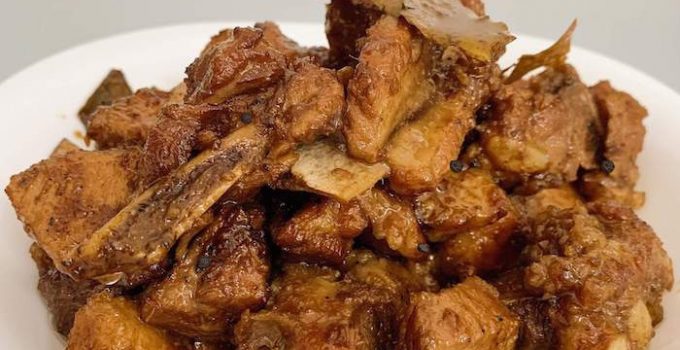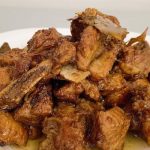I personally think Pork Adobo, or Adobo in general, is the most popular and most iconic Filipino dish in the whole world. When thinking about Filipino food, or even Filipino culture to some extent, Adobo would be one that first comes to mind.
True enough to its reputation, Pork Adobo is one of my most favorite dishes. We have this as our home-cooked meal at least once a month. I believe it’s even once a week for some Filipino families.
In this recipe article, we would be covering what is Pork Adobo, some good-to-know information, how to cook, some notes on the ingredients used, and some cooking tips and secrets.
I hope you take time to read through as this will help you achieve the tastiest Pork Adobo every time.
What is Pork Adobo (Adobong Baboy)?
Pork Adobo or Adobong Baboy is a Filipino dish wherein pork meat is cooked or braised in soy sauce and vinegar alongside spices like garlic, onion, peppercorn, and bay leaves.
Cooking food in vinegar extends the shelf life and I believe this is one of the main reasons why adobo became so popular. It’s just practical for Filipinos to have longer shelf life since food easily spoils here because of the hot climate.
When using pork as the main ingredient for adobo, you’d notice it is tastier compared when using other meat or vegetables. This is because a good amount of fat from the pork mixes with the sauce.
The recipe we are sharing here is as basic as it could get, we will only be using one main ingredient- the pork meat.
I also discovered that there are various ways on how different people cook their basic pork adobo. Most are minor differences on the steps taken to cook the dish. What we will be sharing with you is a classic or authentic way of cooking adobo.
Confusing adobo with humba? Learn the difference here: Adobo Vs Humba
Where is Adobo from?
Like many Filipino foods, pork adobo is also a Spanish-influenced dish. I learned that it came from the word adobar which means marinate. There’s even a dish called Mexican adobo but I don’t think we will confuse the two since they have different ingredients and appearance.
Another surprising good-to-know trivia is that the original adobo is not dark or brown colored. What we know today as adobong puti is how it first looked since we were only using salt back then. It was only when the Chinese traders later introduced the soy sauce that we started using it as a main ingredient in our adobo.
Types and Variations of Adobo
Since this dish is popular nationwide, it’s no surprise that there would be a LOT of types and variations. Each region or people group has their own version or way of cooking this dish.
There are variations wherein we can add different types of secondary ingredients to supplement our pork adobo dish, here are a few of them.
By Add-on Ingredient
- Pork Adobo With Potatoes– Potatoes are good extenders to your pork adobo. Although this will mean carbo-loading especially when you’re having rice as well.
- Pork Adobo With Eggs– It is popular to cook adobo with hard-boiled eggs. Even if it is not cooked together with the dish, hard-boiled eggs are often paired as a side dish.
- Pork Adobo With Tofu– For those looking for extra protein for their meal, tofu is a good partner to pork.
- Pork Adobo With Pineapples– Pineapple in their adobo? Probably half the people would disagree. But nevertheless, it gives a sweet tangy taste to the dish, if you prefer it that way.
- Pork Adobo sa Gata– Gata or coconut milk is a popular ingredient and it is normal for Pinoys to add it to a lot of dishes. Learn more about gata in this article: Gata Vs Kakang Gata
- Spicy Pork Adobo– For hot and spicy lovers out there, this version is definitely for you. A good amount of siling labuyo is added to your basic adobo.
There are also many different types depending on the main meat, seafood, or vegetable used. Here are some of them.
By Primary Ingredient
- Chicken Adobo– I think this is the most popular or the most eaten version of adobo in our country. It is much leaner and also much cheaper to cook compared to the pork adobo.
- Pork and Chicken Adobo– Can’t choose between pork and chicken? Why not have the best of both worlds. You get to eat chicken but get the full taste coming from the pork fat.
- Fish Adobo– Yes we could also use fish, cooked adobo-style. Popular fish choices would be tulingan, bangus, and galunggong.
- Shrimp Adobo (Adobong Hipon)– This is definitely worth the try. Not only do you get to eat this yummy seafood but it is also one of the easiest adobo dishes you get to try. You simply marinate it with the adobo ingredients and cook it along with the marinade.
- Adobong Pusit– This doesn’t look like an adobo dish because of the squid ink sauce. But the same ingredients and method is used to come up with this delicious dish.
- Adobong Tahong– Probably not the most popular way to cook your tahong or mussels. But still you can opt to cook it adobo-style with or without the shell.
- Adobong Kangkong– Cooking kangkong adobo-style is an easy way to add yummy and healthy vegetables to your meals. Most recipes involve added pork but you can also have it without it.
- Adobong Talong– Even if you are not a fan of talong or eggplant, I’m sure you’re going to give it a try when it’s cooking in adobo sauce.
- Adobong Mani– This is one of the best Filipino pulutan or pica-pica. I’m not sure why it is called adobong mani (peanuts) since it is only cooked in garlic and salt and not with the usual adobo ingredients.
Other Unique Variations
- Adobong Puti– As mentioned earlier, this is the real ‘original’ adobo version. It is cooked without the soy sauce giving it a lighter appearance.
- Adobong Dilaw– Here is another version that doesn’t use soy sauce. We use turmeric or ‘luyang dilaw’ to give that yellow appearance.
- Adobong Tuyo– A version wherein we totally evaporate the adobo sauce while cooking. It’s dry nature makes it a good choice as a pulutan or pica-pica.
- Adobo Flakes– This is a twist made from cooked adobo wherein we flake the meat and fry it until crispy. This is perfect as toppings for fried rice or breads.
Ingredients You’ll Need
Pork
I’ve seen different adobo recipes using different pork cuts like pork chop adobo and meatball adobo. But of course the most ideal and popular would be the pork belly (liempo) and pork shoulder (kasim). Here are a few cuts you could choose from:
- Pork belly (liempo)- this is the most popular choice because of its fat content, which results in a very tasty adobo.
- Pork shoulder (kasim)- another popular choice for those looking for a meatier cut and still a good amount of fat.
- Pork ham (pigue)- for those who prefer a leaner (less fatty) meat, this would be a great choice.
- Pork hock (pata)- a lot of Filipino dishes make use of this cut because of the right amount of meats, bones, and skin. This is also a good choice for pork adobo.
Peppercorn
The classic pork adobo recipe calls for whole peppercorns. But in case you don’t have them, you could always use ground peppercorns for this.
Soy sauce
Some prefer dark soy sauce, some prefer light soy sauce, and some prefer a combination of both. I think it’s a matter of preference in taste and appearance but for this recipe, any soy sauce will do.
Vinegar
A good quality white cane vinegar is needed to make adobo. Remember that vinegar doesn’t only give flavor but acts as a natural preservative as well.
Sugar
This is an optional ingredient but I do recommend adding some sugar (white or brown) to achieve a hint of sweetness to your adobo. You can adjust the amount according to your preference.
Aside from the above-mentioned ingredients, you will also be needing aromatics like garlic and onion, bay leaves, and cooking oil for sauteing. If you are filling up your pantry, here’s a handy shopping guide:
Equipment You’ll Need
Adobo is a one-pan dish. This means you will be doing everything on the same pan, from sautéing, searing, and slow-cooking.
- Kawali (Cooking Pan)- You will be using the traditional Filipino kawali for this dish. Having a deep bottom will allow to you to braise the meat in water, vinegar, and soy sauce. Make sure you also have a lid for your pan as you will need to cover while cooking.
In need of kitchen tools and equipment? Read this before you buy:
How To Cook Pork Adobo
As mentioned earlier, there are many different approaches in cooking pork adobo. We will share with you an easier and more straightforward way of doing this. We have been using this recipe for years and we can guarantee the quality of its taste.
There are two major parts in cooking pork adobo, three if you will be marinating your meat, but we won’t be doing that this time.
First part is the sautéing of the pork meat along with some aromatics. This is the part where we infuse the delicious flavors of the garlic and onion to the meat.
The second part involves simmering or ‘slow-cooking’ the meat in water, soy sauce, and vinegar. This will make the meat tender and allow it to absorb the flavors from the sauce.
For the complete ingredients and step by step procedure, refer to the recipe box below.
Also, continue reading to learn more about the ingredients, some cooking tips, and troubleshooting that can definitely help you achieve the perfect pork adobo.
Cooking Tips and Troubleshooting
Here are some cooking tips you could use and some remedies you could try in case you encountered problems while cooking:
- When sauteing the pork meat, it is important that you thoroughly do this. So it is advisable that you use a wider pan to properly fit and cook the meat you place in it. In case you don’t have one, you could saute the meat in batches.
- We may be using different brands and types of condiments used in this recipe. That’s why we recommend that you taste them first before using them. This way you could adjust accordingly.
- What will I do if my adobo is too salty? You could counter this by adding sugar, lemon, or olive oil. But be careful and add them little by little until you achieve your preferred taste.
- What will I do if my adobo is too sour? You could counter this by adding sugar and water. Again, do this gradually and taste from time to time.
- To learn more about cooking tips like troubleshooting and the likes, see: 8 Cooking Tips For Pinoys
How To Serve Pork Adobo
Pork Adobo is best served warm with freshly cooked white rice (yum!). It also works well with garlic fried rice.
In case you need to have it as a packed lunch, don’t worry, it’ll still taste good. You can even try doing it ‘binalot’ style by packing it in banana leaves for more authenticity.
Also, this is a very meaty dish so you can also serve this alongside popular Filipino side dishes like achara, tomato-salted egg ensalada, or buttered vegetables.
Source: flickr.com/photos/rhoisolis/8201809262
How to Store and Reheat
As mentioned earlier, adobo is naturally preserved with the vinegar and it can last for up to 3 days at room temperature. If you want it last longer than this, place it a clean container with lid and refrigerate.
To reheat, you can use a microwave oven or on a stovetop with minimal heat.
For a quick reference about this recipe, see the recipe table below:
Pork Adobo (Adobong Baboy) Recipe
Equipment
- Cooking Pan
Ingredients
- 1 kg (or 35 oz) pork liempo (belly), you could also use other cuts, see notes above
- 1 whole garlic, chopped
- 1 pc large-sized red onion, chopped
- 1 tsp whole peppercorn (pamintang buo)
- 6 pcs laurel leaves (bay leaves)
- 1/4 cup soy sauce
- 1/4 cup vinegar
- 3 tbsp sugar, optional
Instructions
- Heat some oil in a wide pan and saute the onion and the garlic.
- When the onion gets soft, add-in the pork and brown all sides.
- Add-in the soy sauce and the black pepper then mix well.
- Pour in some water until all the meat is covered. Add-in the laurel leaves.
- If you prefer a sweeter adobo, you may add-in the sugar then mix well.
- Add-in the vinegar and do not mix after this.
- Continue to simmer in low heat until the liquid evaporates and the meat releases its natural oil.
- Remove from heat and transfer to a serving bowl. Enjoy!
Notes
Nutrition
Pin and save this recipe to your Pinterest account! Click on the Pin button above 🙂
Thank you and I hope you find this article useful! It’ll mean a lot if you RATE THE RECIPE by clicking the stars and SHARE THIS TO YOUR FRIENDS! 🙂





how do you cook the chicken and pork adobo?